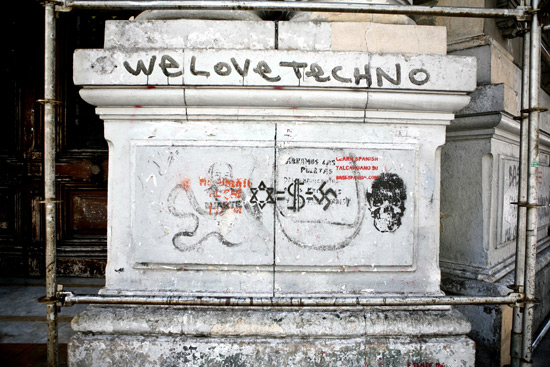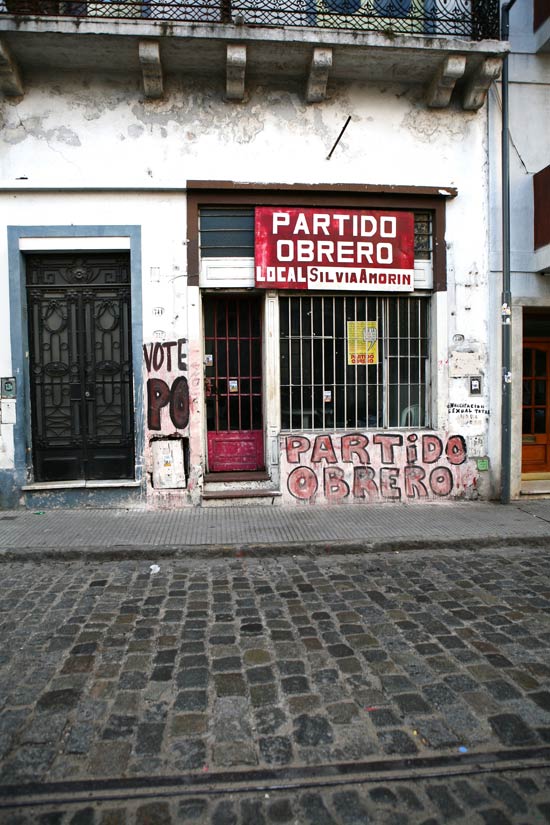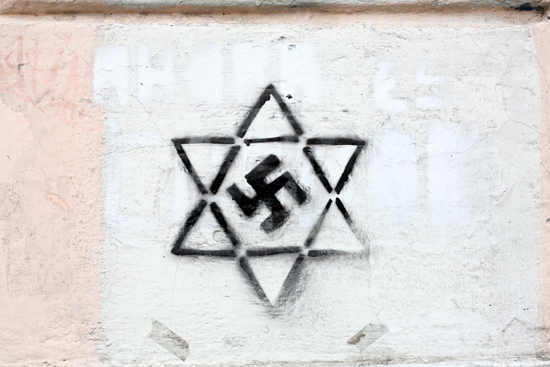I saw it from the other side of the street, the corner of Chacabuco and Carlos Calvo, two blocks away from my apartment. I stopped. People continued to walk by — a man, a woman and child, a group of teenagers blasting Cumbia music. No one else noticed. I looked both ways and crossed the street to get a closer look, a confirmation that this was reality. The black spray-paint looked fresh, and I touched it, immediately checking around me to see if the painter was nearby, still stenciling. Two cop cars drove by. I took out my camera to photograph it. My first swastika.
My bewilderment slowly turned to curiosity and then quickly into fear. I had seen swastikas before, but only in dark movie theaters and on glossy textbook pages. I had always been a passive observer. I could be eating popcorn or highlighting dates. I thought the swastika was meant for Jews with German accents, waiting in long breadlines, not for me. Whatever vestige that remained of its original meaning had been reinvented for contemporary use. Who was its maker? How many of them were there in the city? Is my new home away from home not safe? What does it mean? Eventually I would read the image to be a comment on Israel’s current military actions, but at the time all I felt was the urgency and adrenaline of alarm.
With the rise in anti-Semitic attacks across Europe and the number of Latin American protests of the war in Gaza, I had begun to wonder about my safety and the general safety of other Jews in the world. Given Buenos Aires’ history of being both a sanctuary for Jews as well as Nazis, this one piece of graffiti should have the ability to shock and incite people into action or at least contemplation.

I took my thoughts with me to dinner, where I and a few other journalists convened after a brief milonga (tango dance). Rather than discuss the situation or the sentiments that were expressed, I was met with opposition. My colleagues were more concerned that I had never seen a swastika before than they were alarmed by what I had seen on my block, as if it should have been a part of my regular life, a rite of passage that every minority surely endures. They assured me that the graffiti I had witnessed was not part of a larger phenomenon, but the result of the actions of a hateful, ignorant few.
Yet in the coming days, news reports of similar swastikas being found all over the city — most shockingly nearby a children’s hospital — continued to pour in. I saw them on my way to work, on the walls across my sips of coffee, and the seeming indifference of the streets persisted. It wasn’t until the comments of an Argentine bishop were heard around the world that my peers understood my alarm. Something new was going on in Argentina.
I decided to sit down with Ana Weinstein, one of the directors of the Argentine Israelite Mutual Association (AMIA), a Jewish organization in Buenos Aires, to get a better understanding of the precedence and response to anti-Semitism in Argentina. She warned me to bring my passport, as security in the building was on high alert. On July 18, 1994, a car bomb exploded outside the original building, killing 85 people and injuring hundreds. This attack came after the 1992 bombing of the Israeli Embassy, in which 22 people were killed. All this was common knowledge, as was the fact that authorities have been unable to locate those responsible for either bombing. Reports trickle in on occasion, telling of torture and violence for those who choose to investigate the tragedies. All Jewish affiliate buildings in the city maintain strict security.
When I arrived, a man in camouflage slacks spoke loudly on his cell phone. He screened my passport and led me inside, past a metal detector and two steel doors. I was excited to find all the contents of a Jewish Community Center in America — message boards with Jewish film screenings, lectures, and a cafeteria with knishes.
Up the elevator and to the left, I found Mrs. Weinstein, who greeted me with a hug and a kiss. A man brought us mate cocido, and we sat down to chat.
My prepared questions were met with complications. As an accomplished sociologist and leader of the Jewish community, Mrs. Weinstein deconstructed what my college professors had taught me to call “hate crimes,” “discrimination,” and “anti-Semitism.” It was all a bit trickier than that.
She described to me the history of the Jewish people in Argentina as well as the history of Nazi sympathies by the last dictatorship. In the middle of the century, Mrs. Weinstein explained, “There were ties between the military of Argentina and Nazi organizations. The regime was friendly to another fascist state.”
These political policies bled into the populace through their appeal: “Every family had a member in the armed forces, a lawyer or a politician, and a member of the church — let’s say a nun or a priest. Then there were these outsiders, Jewish people.” With such strong ties to organizations sympathetic to Nazi beliefs, sentiments were transmitted into the nuclear family. “For them the Nazi ideology was music to their ears. Nazis could enter Argentina easier than the survivors of the Shoa.”
With the return of democracy in 1983 and the rise of Alfonsin, the Jewish community welcomed the pluralism promised by a new democratic society. She described how 10 years later, after the 1994 bombings of AMIA, a different Argentina could be seen.
“Society felt hurt by the bombing and was ashamed. It is now better understood what it is to be Jewish; we are also Argentineans.” The economic crisis of 2001 provided similar solidarity between the Jewish community and the rest of nation. As thousands of people lost their jobs, savings, and direction, AMIA and other Jewish organizations opened up their resources to include all sects of people. Reaching out to everyone, they offered food, health, and job assistance. “AMIA recovered despite the severe attack to help others, and cared not only for Jews. We proved we are a positive presence within society, and anti-Semitism diminished.”
Anti-discrimination laws were passed, and the Delegation of Israeli and Argentine Relations was founded to monitor activities considered to be discriminatory. However, Mrs. Weinstein was careful to explain, “This does not mean anti-Semitism disappeared. More extreme parties who are anti-Israel, Yanqui, and Zionist have appeared. Groups like Quebracha and Partido Obrero attack Israel to support Palestine, or attack America to support Iran, but it is more complicated than that. There is a belief that Israel should have a right to exist and preserve itself. And separately, there are the actions of that state. The dialogue between Israel and the Diaspora is seen as unconditional support. They do not dare to see the distinction between Hamas and the Palestinian authority, and so an unconditional support of Israel is met with an unconditional support of Palestine.”

So who was the maker of the swastika? Partido Obrero? Quebracho? Or was it simply the psyche of the Argentine public scrawled on the walls? Should I be afraid?
Mrs. Weinstein mused over the question and responded, “It is a very strange moment. I’m worried; I’m not scared. There was a leader of one of the groups that announced, ‘You don’t have to look for the Jews in Gaza. You can find them here in their synagogues.’ It’s a change.”
I asked her what contact she had with these groups that might be responsible for perpetuating the swastika within the Jewish star, and her body language closed, and she grew very serious. “You cannot talk to those people. They do not understand what they do.” She warned me not to contact them, that they would tell by my accent I was Jewish, American, and everything they despised. I would be endangered should I make myself known to them. With my questions somewhat answered, I said good-bye and found my exit out of the fortress.
She did not dissuade my fears but only allowed me to grow more aware of certain paranoia always present in the back of my mind. Whether or not I agreed with the actions of Israel, I had been collapsing a pro-Palestinian argument with an anti-Semitic one. My head full of discomforting realizations, I walked past a congregation of young protestors waving newspapers. The front page bore an image of Palestinian victims from attacks in Gaza, with the words “La Solucion Final” (The Final Solution). It was members of the group Partido Obrero.
They looked like I did: mid-20s, jeans, funky sunglasses. I stopped and asked for a paper. “Would you like to get involved in the fight?” the girl asked me. I was about to make my father cringe and attempt to face generations of paranoia and fear. “Yes, I would like to know more.” I put my cell phone number down and wrote “Emilia,” my best attempt at masking my identity. I opened my purse, foolishly stuffed with Hebrew pamphlets I had picked up at AMIA, and paid the two pesos for the paper. She promised to call me for the next meeting. I exhaled. Marianela seemed pretty harmless.
The anonymous writer of the main article wrote, “The massacre in Gaza is a final solution to the Palestinian question… They act, without regard, from a barbaric and reactionary fantasy that no doubt will be like the final solution that Hitlerism intended against the Jewish community.”
The sentence “the final solution” caught my attention. Words like these and swastikas were once specific — to refer to Hitler and World War II. I always thought these ideas were instrumental in the creation of Israel, as they were the harbingers of Jewish suffering and the ideology behind the need for Israel to exist. When these words are used against Israel in this way, it destroys the reasoning behind Israel’s existence. If the Holocaust was the reason for Israel, and Israel causes a holocaust, then Israel loses its identity as a victim state. Those who were once oppressed have become the oppressors. This re-appropriation Holocaust terminology was not pro-Palestinian, but anti-Israel. Equating a Jewish star with a Nazi symbol achieves the same effect, only it’s not just anti-Israel — it’s anti-Semitic.
I met Marianela and her boyfriend Emiliano at a café in the center of the city. They brought along Marianela’s younger brother, who sipped on chocolate milk as we discussed the mission of Partido Obrero. The Trotskyist political party is the largest section of the Coordinating Committee for the Refoundation of the Fourth International, with its primary support amongst youths. Having formed in the middle of the 20th century, Partido Obrero was the host of the 2004 Movement for the Refoundation of the Fourth International, and the party has offices in Greece, China, and Venezuela.
I didn’t tell them I was a journalist and a Jew until we were an hour into our discussion of capitalism, class, and the seeming plethora of evils in the world perpetuated by the Jews, imperialists, and fascists. Emiliano used all these terms interchangeably until I stopped him and asked to record the remainder of the interview. I unmasked myself as a Jew and kindly asked him if he understood the difference between a Jew and an Israeli, to which he replied “of course.”
From then on, we talked in specifics about the mission statement of the organization. Emiliano is the leader of the Partido Obrero at the University of Buenos Aires’ School of Engineering, where he “organizes different activities around politics and sets up discussion meetings to come up with ways to solve the problems of the working class.”
With regard to Gaza, he eloquently described the situation and had a very clear argument: “I believe, firstly, that it is a mistake to call it a war. A war is a conflict between two governments or two states with opposing ideas or interests. There is no Palestinian government, so there can be no war. It is just a massacre. They are a community who oppose the Israeli rule. It’s a war crime. They are fighting for basic human rights: education, clean water, electricity, and we identify with their cause. We want to help them fight.” Marianela agreed, nodding her head.

He went on: “The Jews believe they have an excuse to maintain and perpetuate this wrong, but they do not… We aim to recognize that this isn’t a question of race; it’s not Jews or Israelis against Palestinians, but a state expanding with pro-imperialistic policies in line with the other imperialistic powers of the world. We’re talking about Sarkozi in France, Zapatero in Spain, Putin in Russia, Bush and his successor Obama — all of the leaders of nations employing new colonialism.”
I felt as if his answers were rehearsed, and unfortunately he had forgotten to make the distinction between Jews and the Israeli government. I felt like I was one of the first Jewish people he had ever met, and he too was shocked to see how similar I was to him in size and age.
And what would be the goal of this organization? What was it calling for?
“We want for all of the working class to unite against this injustice, to demand the troops be removed from Gaza. We want the proletariat of the world to go to the Israeli embassies and defend the Palestinian people during this massacre.” He was discussing peaceful protest; he did not advocate violence, but somewhere along the line I could see how this message could be misinterpreted. Mrs. Weinstein’s comments were echoing in my ears.
Finally I asked him about the front cover of the newspaper. I asked him about the swastika. Neither referred to the Holocaust, he told me. “The photo on the front of the paper is supposed to ask, ‘What is the truth of this action? What is Israel really doing to the people of Palestine? Why are they using this force?’ The only solution for capitalism is violence, to solve the financial crisis of the world. I did not know it had anything to do with Hitler.”
He then went on to explain to me the true identity of Hitler and how my alarm was misplaced.
“Hitler was born of a political and militant movement to fight the socialism of Russia. He became a fascist to organize the German people to fight insurgents and motivated the masses not only against Jewish people, but against Gypsies and homosexuals to maintain a regime of oppression. We don’t know who makes the stars, but they are misguided. We don’t have the same intention of whoever makes them. These drawings, this graffiti, I believe is wrong. We don’t believe that the state of Israel is a fascist state; it is not the same as Hitler.” I felt that to deny Hitler’s position and role as an ethnic cleanser and leader of genocide equally demeaned the message of the party.
The café’s tango music played on, and I stared blankly across the table. It was true that he didn’t understand the history of the Jewish state, but it was not malice that kept these two fighting for Palestine. In fact, Emiliano proudly commented, “Many Jews have written for Partido Obrero against the massacre in Gaza. I don’t know them, but they are members just like me.”
After following him in his circles, I posed one last question: “What is and where does anti-Semitism come from?”
Succinctly he responded, “The fact that the Jewish community has organized a state means that they have organized a society under a system of exploitation. A part of the society has taken power of the production to keep the rest of the population oppressed. The Jewish state has not been created based on the Jewish community needs but only on the needs of just part of the community. To support this system, they need to support anti-Semitism to keep the people afraid.”
After four hours of interviewing Emiliano, he invited me to a party on Friday that was being held by Partido Obrero. I told him I would think about it. I checked the address of the party; it was at its headquarters, a block away from my apartment. It was close, convenient, and maybe it would be a good idea to improve relations. I was ashamed at the courage it took to talk to them in the first place. My concern stemmed from an uncertain place and from fear, and perhaps because of the solitude of a year of expatriate life, I decided it would be a worthwhile endeavor to confront my fear head-on. I could go and represent Judaism; I could show them what I wasn’t. On my walk over I realized it probably wasn’t a good idea. A few meters away from Partido Obrero’s door, I passed the first swastika, black and bold, still unraveling my sense of self and the political party’s definitions of truth.

emily anne epstein
Dear Reader,
In The Fray is a nonprofit staffed by volunteers. If you liked this piece, could you
please donate $10? If you want to help, you can also:










